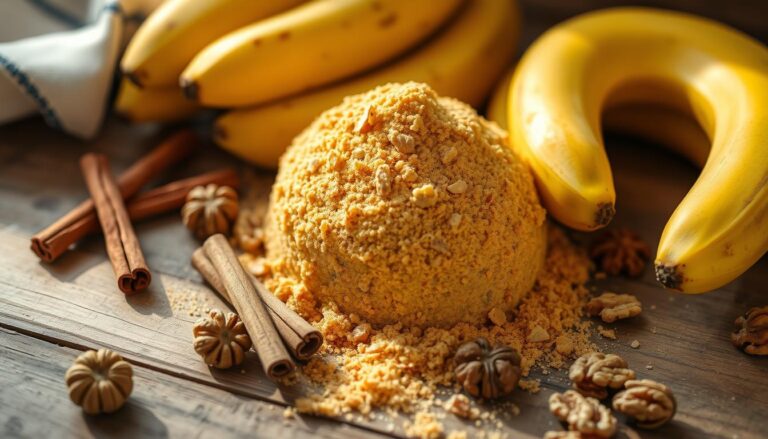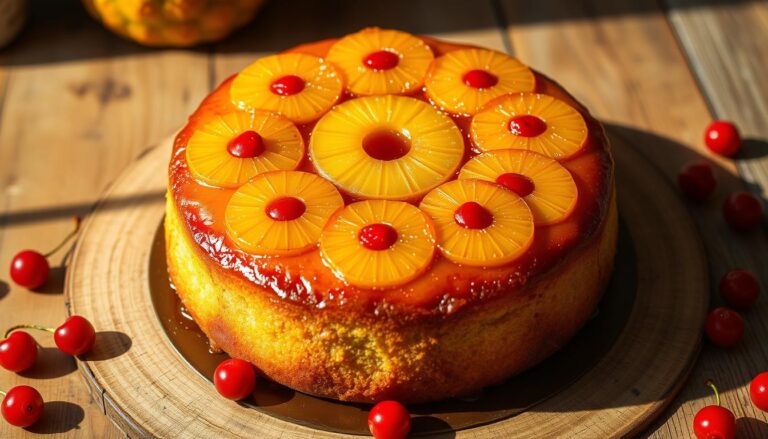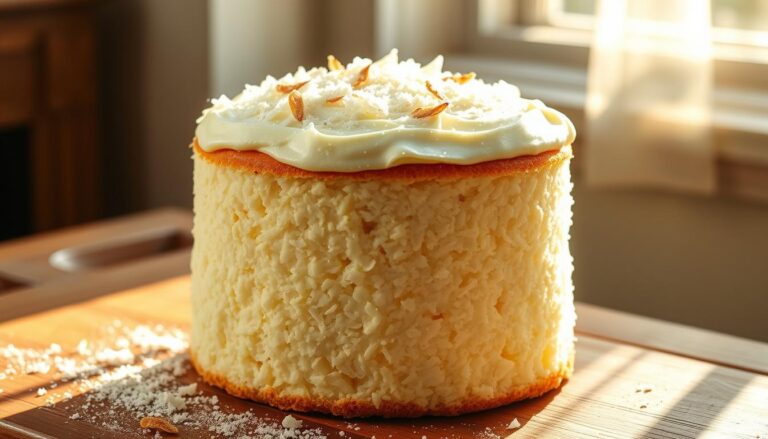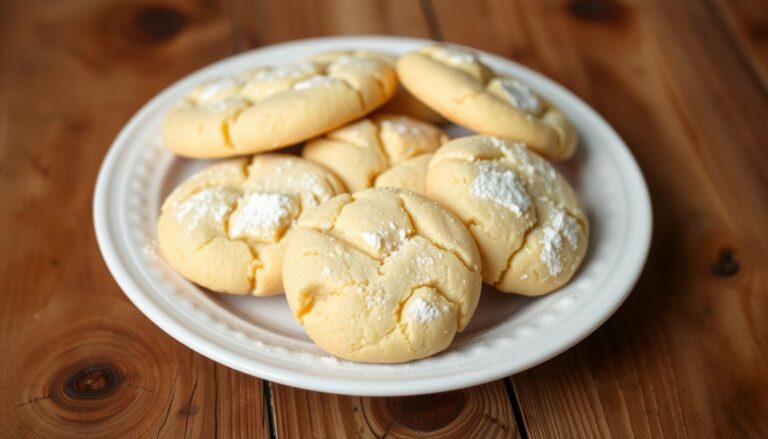Delightful Coconut Cake: A Tropical Delight
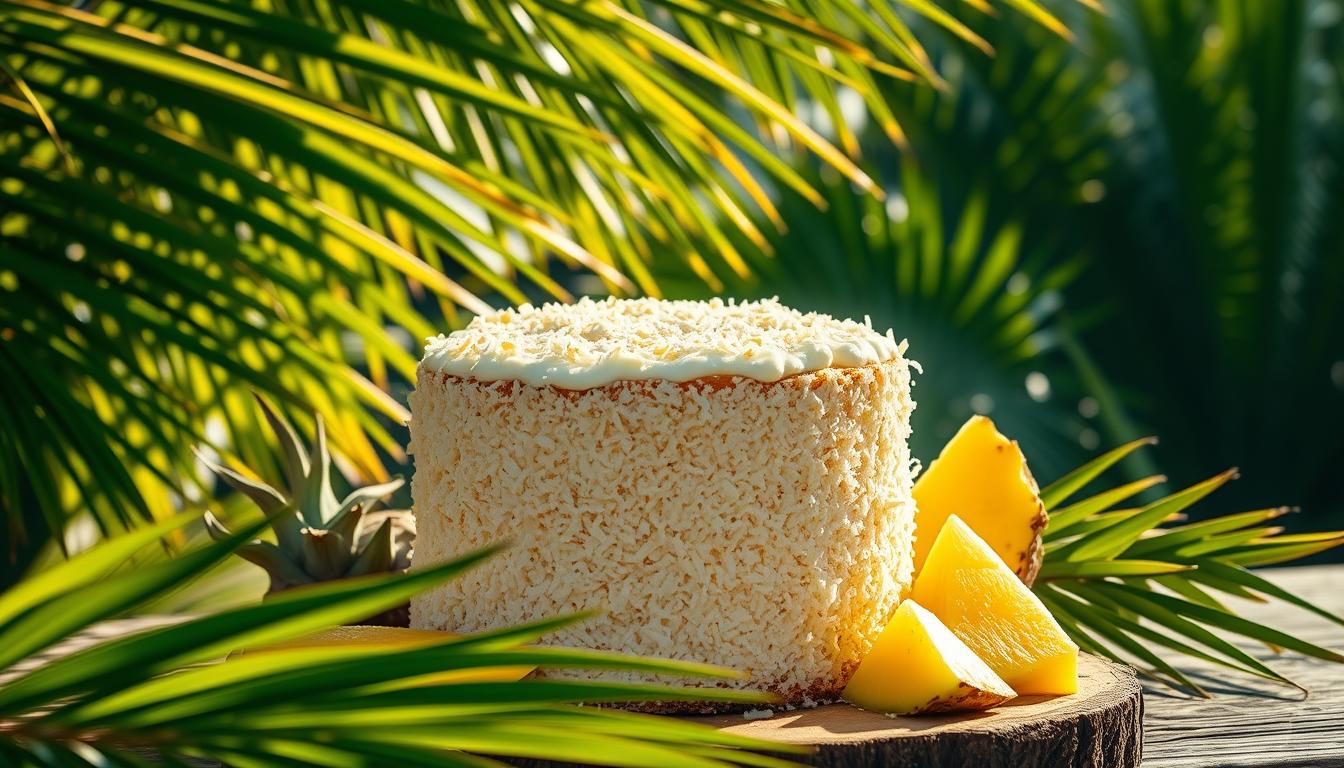
Every summer, our family gatherings become sweet celebrations. The star of these gatherings is the incredible coconut cake. When the first slice comes out, filled with tropical scent, everyone’s eyes light up.
This dessert is more than just a treat. It’s a tradition that brings us joy and connects us to happy memories. It reminds us of warm sunshine and fun times.
The best coconut cake is a journey to beautiful beaches and lush landscapes. It’s not just about the ingredients. It’s about creating a delightful experience for all your senses.
Whether it’s at a backyard barbecue or an elegant dinner party, coconut cake is a hit. Its creamy texture and sweet taste please everyone. It’s loved by all, no matter the age or the occasion.
Table of Contents
Key Takeaways
- Coconut cake offers a tropical flavor experience
- Perfect for various social gatherings and celebrations
- Combines rich texture with delicate sweetness
- Connects culinary tradition with sensory memories
- Versatile dessert suitable for multiple occasions
Understanding the Magic of Coconut Cake
Coconut cake is a journey through tropical baking traditions. Making it from scratch opens a world of rich flavors and cultural heritage. This spans generations.
Our look into this dessert shows its origins and why it’s loved worldwide. It has grown from a simple treat to a global favorite. It charms with its unique texture and flavor.
The History of Tropical Baking
Tropical areas have always valued coconut. Coconut cake comes from these traditions, mixing local ingredients with new baking ways. Its roots are in:
- Caribbean island cuisines
- Southeast Asian baking traditions
- South Pacific cooking methods
Why Coconut Cake Remains a Classic Favorite
A homemade coconut cake is a treat for the senses. It’s loved for:
- Its creamy texture
- Complex flavors
- Nostalgic memories
Essential Components of a Perfect Coconut Cake
To make a great coconut cake, you need to know the key ingredients and techniques. We focus on using different coconut products for depth and authenticity.
The best coconut cakes have:
- Coconut milk for moisture
- Fresh coconut flakes for texture
- Cream of coconut for flavor
By combining traditional methods with modern baking, we create a dessert that delights people everywhere.
Essential Ingredients for the Perfect Coconut Cake
To make a delicious coconut cake, you need the right ingredients. They must work together to create a moist cake with amazing flavor and texture. Let’s dive into what makes a coconut cake special.
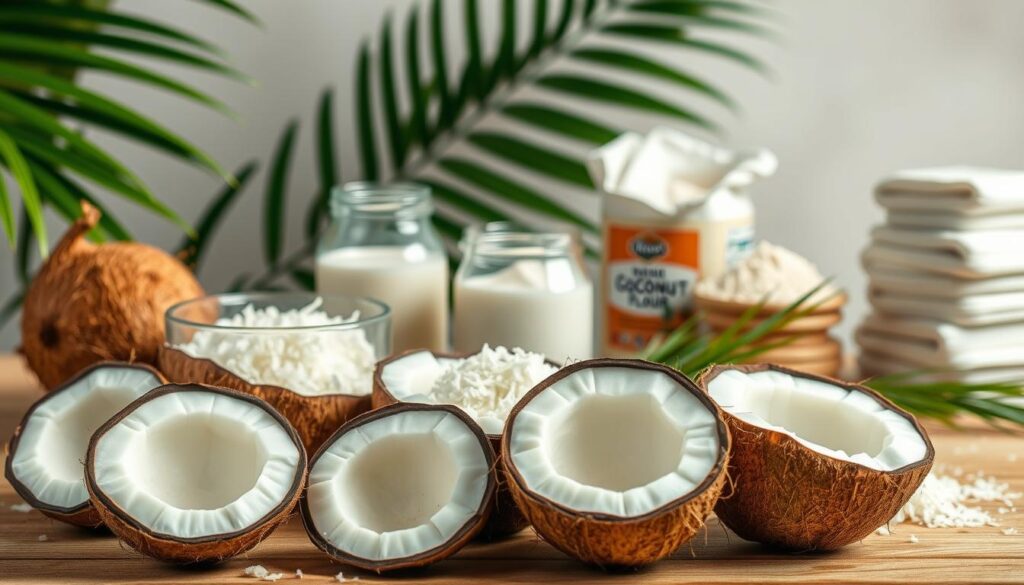
Here are the key ingredients that turn a simple cake into a tropical treat:
- Cake Flour: Makes the cake soft and tender
- Coconut Milk: Adds moisture and a strong coconut taste
- Egg Whites: Help the cake stay light and fluffy
- Sour Cream: Makes the cake extra soft
- Coconut Extract: Boosts the coconut flavor
The secret to a great coconut cake is finding the right balance of ingredients. Canned coconut milk is key for its moisture and flavor. Use full-fat coconut milk for the best taste and texture.
Professional bakers know each ingredient has its role. Unsalted butter adds richness, and buttermilk makes the cake rise. Sweetened shredded coconut adds flavor and texture.
Baking is a delicate science where each ingredient matters!
When picking ingredients for your coconut cake, choose the best. Fresh vanilla, high-quality coconut milk, and premium butter make a big difference. They can take your cake from good to amazing.
The Secret to a Moist and Fluffy Texture
Making a moist and fluffy coconut cake is more than just a recipe. Our expert bakers have found special techniques. These turn a simple cake into a memorable treat.
To make a remarkable moist coconut cake, you need to know a few key things. These elements are what make a coconut dessert truly special.
Coconut Milk: The Moisture Magic
Coconut milk is crucial for a moist coconut cake. Its creamy texture adds:
- Extra moisture
- Deep tropical flavor
- A tender crumb
Precision in Mixing Techniques
Getting the right texture means mixing carefully. Here’s how to do it:
- Use room temperature ingredients
- Fold gently
- Avoid mixing too much
Temperature Considerations
Temperature affects the cake’s texture a lot. Here are some tips:
| Ingredient | Recommended Temperature | Purpose |
|---|---|---|
| Eggs | Room Temperature | Better incorporation |
| Butter | Softened | Smoother mixing |
| Coconut Milk | Room Temperature | Consistent blending |
Mastering these techniques will boost your baking skills. You’ll make a moist coconut cake that wows everyone.
Creating the Ultimate Coconut Cake Base

Making a coconut cake from scratch needs care and love. Our homemade coconut cake base is the start of a dessert that will take you to a tropical paradise.
The secret to a great coconut cake is choosing the right ingredients and mixing them well. We’ll show you how to make a cake base that’s light, fluffy, and full of coconut flavor.
- Use room temperature ingredients for smooth blending
- Sift dry ingredients to prevent lumps
- Cream butter and sugar until light and fluffy
- Incorporate coconut milk for rich moisture
Here are the key steps for your homemade coconut cake base:
- Prepare your baking pans by greasing and lining with parchment paper
- Preheat the oven to 350°F (175°C)
- Combine dry ingredients thoroughly
- Cream butter and sugar until pale and voluminous
- Gradually mix in wet ingredients
Getting the right texture is important. Whip egg whites separately for a lighter cake. Then, gently fold them into the batter to keep it airy and delicate.
Pro tip: Don’t overmix the batter – this can lead to a dense, tough cake.
Our method ensures your coconut cake will be a hit. It will be moist, flavorful, and irresistible.
Mastering the Coconut Cream Filling
Making the perfect filling is key to a top-notch coconut cake. A rich, creamy coconut filling turns a simple cake into a tropical dream.
Our coconut cake’s success comes from its special cream filling. It adds moisture and flavor to every bite. The right filling can make your cake go from good to amazing.
Exploring Coconut Filling Varieties
- Classic Coconut Cream Filling: Made with sweetened coconut flakes, half-and-half, and vanilla extract
- Coconut Milk-Based Filling: Using unsweetened coconut milk for a richer texture
- Pastry Cream Variation: Incorporating toasted coconut for added depth
Preparation Techniques
Getting the coconut cream filling right needs focus. Use fresh ingredients and temper egg yolks for a smooth texture.
- Combine coconut milk, sugar, and cornstarch
- Slowly add egg yolks
- Cook until thickened, stirring constantly
- Add butter and vanilla extract
Storage Recommendations
Keeping your coconut cake fresh is crucial. Store it in the fridge for 2-3 days. This keeps it fresh and tasty.
Pro tip: Always cover the cake loosely to prevent moisture loss and preserve its incredible flavor.
Perfecting the Coconut Buttercream Frosting
Making the perfect frosting is key for a top-notch coconut cake. Our simple coconut cake recipe turns a basic dessert into a tropical dream. This is thanks to our frosting techniques.
A great buttercream needs to be smooth and creamy. Use high-quality unsalted butter at room temperature for the best base. Precision matters when mixing ingredients.
- Start with softened butter (not melted)
- Gradually add powdered sugar
- Incorporate coconut extract for intense flavor
- Beat until light and fluffy
For a tangy twist, try cream cheese frosting. It pairs well with coconut, making the cake rich and decadent.
“The secret to an incredible frosting is balance – between sweetness, texture, and flavor.”
When making your coconut cake with cream cheese frosting, temperature is important. Make sure all ingredients are at room temperature. This helps with blending and achieving a smooth finish.
- Use an electric mixer for best results
- Avoid overmixing to prevent grainy texture
- Chill frosting briefly if too soft
Our easy coconut cake recipe makes baking at home feel like a pro job. The frosting will wow your family and guests.
Professional Tips for Cake Assembly
Making a perfect coconut layer cake needs skill and precision. Our expert baking tips will turn a good cake into a masterpiece. Whether it’s for a special event or just for fun, these tips will make your cake stand out.
Layering Techniques for Optimal Results
Getting even layers is key for a beautiful coconut layer cake. Here are some important steps:
- Use a serrated knife to level cake layers carefully
- Chill cakes for 30 minutes before cutting to reduce crumbling
- Invest in a cake leveler for consistently precise cuts
- Allow layers to cool completely before assembling
Professional Frosting Application Methods
Smooth frosting makes a cake look professional. Try these methods:
- Apply a thin crumb coat and refrigerate for 15 minutes
- Use an offset spatula for even frosting distribution
- Rotate cake while applying frosting for consistent coverage
Decorative Finishing Touches
The final touches make your cake look amazing. Here are some ideas:
| Decoration Technique | Visual Impact |
|---|---|
| Toasted coconut flakes | Adds texture and authentic tropical flavor |
| Piped buttercream rosettes | Creates elegant, professional border |
| Edible flowers | Provides sophisticated, natural accent |
Finish your cake with toasted coconut flakes on top. It adds crunch and looks great, impressing everyone.
Variations and Creative Twists
A homemade coconut cake is a canvas for creativity. We’ve found many ways to make the classic recipe your own. Its versatility lets you explore different flavors and baking styles.
Here are some exciting variations to take your coconut cake to the next level:
- Tropical Fruit Infusions: Add pineapple, mango, or passion fruit for a tropical twist
- Chocolate-Coconut Fusion: Mix in dark chocolate or cocoa powder for a rich taste
- Nutty Enhancements: Try toasted macadamia or almond fragments for extra texture
Looking for a milder coconut cake? Swap some coconut ingredients with milder ones. This will give you a less intense flavor.
| Variation Type | Key Ingredients | Flavor Profile |
|---|---|---|
| Tropical Fusion | Fresh pineapple, coconut milk | Bright, refreshing |
| Chocolate Coconut | Cocoa powder, coconut flakes | Rich, indulgent |
| Nutty Coconut | Toasted macadamia nuts | Crunchy, complex |
Our top tip for a unique coconut cake is to experiment boldly. Mix unexpected ingredients and techniques. Keep the cake moist and coconut-rich while adding your own twist.
Storage and Serving Recommendations
Keeping a moist coconut cake fresh is key. Our tips will ensure your tropical treat stays delicious from start to finish.
Storing your cake right is essential. Here’s how to keep it fresh:
- Refrigerate the cake in an airtight container
- Keep it at 36-40°F
- Use plastic wrap to prevent moisture loss
- Eat it within 3-4 days for the best taste
When it’s time to serve, let the cake sit out for 30-45 minutes. This step makes it soft and flavorful again.
Choosing the right drinks or desserts can make your coconut cake even better:
- Beverage pairings: Try tropical smoothies, coconut water, or coffee
- Complementary desserts: Add fresh pineapple or mango sorbet
If you want to keep the cake longer, freezing is a great choice. Wrap it well in plastic and foil. Frozen cake stays good for a month.
Conclusion
Baking the ultimate coconut cake is more than a recipe; it’s an art. It needs patience, skill, and a love for delicious flavors. By mastering each step, from choosing the best ingredients to frosting, you can make a simple dessert into a masterpiece.
Making coconut cake from scratch is about more than following a recipe. It’s about learning the techniques that make a cake stand out. We’ve looked at how to control moisture, balance flavors, and present the cake beautifully. This creates a dessert that’s both traditional and innovative.
Every baker should feel free to add their own twist to this recipe. Whether you’re new to baking or have lots of experience, making a homemade coconut cake is incredibly rewarding. Our guide is just the start, and your creativity will turn it into a dessert that wows everyone.
Remember, the more you bake, the better you’ll get. Each time you make this coconut cake, you’ll become more confident and skilled. The process of making the best coconut cake is as enjoyable as the taste itself. It shows that baking is both an art and a tasty journey.
FAQ
What makes a coconut cake different from other cakes?
How can I ensure my coconut cake stays moist?
Can I make a coconut cake if I’m not an experienced baker?
What type of frosting works best with coconut cake?
How long will a homemade coconut cake stay fresh?
Can I make a coconut cake in advance?
Are there any gluten-free options for coconut cake?
What are some creative variations of coconut cake?
Leave a review :
There are no reviews yet. Be the first one to write one.


